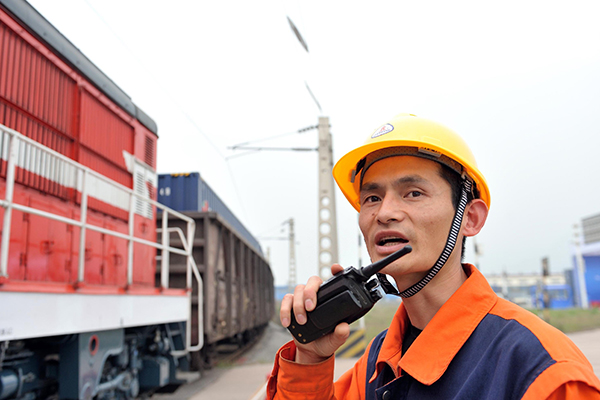Rail drives cross-border e-commerce
 |
|
A worker directs a cargo train returning from Europe into the station in Chongqing. The Chongqing-Xinjiang-Europe railway is driving the fast growth in cross-border trade. [Photo/Xinhua] |
Fifteen days after departing Chongqing in southwestern China on Sept 29, 139 parcels arrived in a processing center in Frankfurt for delivery to people across Germany. The packages included storage boxes, stuffed toys and Chongqing local specialties.
Though the parcels were few in number, their delivery marked the successful test of mail delivery via the China-Europe railway system. Cross-border e-commerce platforms such as DHGate have been notified to prepare for another test, during which their products will be sold and shipped to Russia and Germany via the railway.
The past few years have seen burgeoning sales in cross-border online shopping, but traditional sea and air postal routes have hampered its expansion.
China's total transaction volumes in cross-border e-commerce reached 5.4 trillion yuan ($810 billion) in 2015, up 28.6 percent year-on-year, said a report issued by China e-Business Research Center.
Global trade growth has been slower than economic growth for four years, but cross-border e-commerce has grown quickly because it has reduced trading costs and streamlined the international trading chain, said Lu Pengqi, deputy head with the China Council for the Promotion of International Trade at the 19th China International Fair for Investment and Trade in September.
According to the municipal railway authority, a parcel sent from Chongqing will arrive in Germany at least 20 days faster via China-Europe regular trains than by sea. The cost is just one-fifth of that by air, making the train highly cost-effective.
However, a 1956 convention passed by members of the Organization for Co-operation between Railways prohibited mail delivery through international railway cargo transport. In early June 2014, the OSJD finally deleted the related clause.
During a postal service forum in April in Chongqing, a declaration was made to guarantee international cooperation in mail services-via the China-Europe railway-and to provide road routes compatible with cross-border e-commerce.
Following the declaration, in May Chongqing became China's first pilot city approved by the General Administration of Customs to run the China-Europe railway mail service. Chongqing-Xinjiang-Europe regular cargo trains were assigned to carry out the service.
According to an official at the Chongqing Customs, the Chongqing-Xinjiang-Europe railway transports nearly 50 percent of freight from China to Europe every year.
The volume of cross-border e-commerce in the city exceeded 6 billion yuan last year, up from 60 million yuan two years ago.
The test run also highlighted innovations in management. Improved "smart" customs locks were used for monitoring parcels and facilitating clearance at the departure, the transfer depot and exit. It was the first time Chinese customs officials and the postal service shared data.
The China-Europe railway mail service has adopted electronic customs clearance, rather than manual clearance, allowing the parcels to remain unopened and stay on the same train for the entire trip.

















